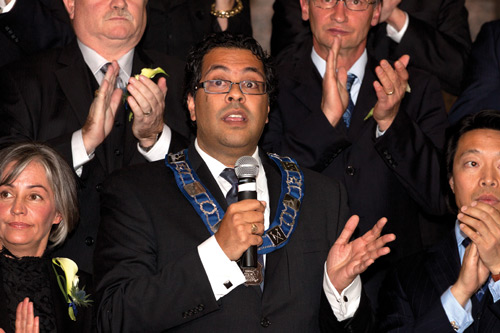Youth voting: trend or illusion?

Photo by Bryan Weismiller. Naheed Nenshi’s “purple army” rapidly grew in numbers leading up to the Oct. 18 municipal election.
by Vini Rocha
Last October, Calgary saw an impressive voter turnout with 53 per cent of eligible citizens casting a vote and surprisingly, many young voters turned out to the polls. In the coming weeks, we will see whether that political fever transfers over to the 2011 Students’ Association elections.
University student elections have long been plagued with low interest and lower —percentage turn out, such as the 8.27 per cent of the student body who voted in the Mount Royal’s 2010 Students’ Association elections last year.
Last year’s incentives — such as free cookies and gift card draws — may have contributed to an increase from the 5.53 per cent who voted in the March 2009 SAMRU election.
The numbers were also dissapointing compared to the 10.22 per cent who marked a ballot in the December 2008 campus by-election.There is reason for optimisim though, as the 2010 municipal election spurred the largest turnout in Calgary’s history.
Growing discontent with a divisive city council and a wide-open mayoral race helped create the conditions necessary for change.
Backed by a passionate group of followers, Naheed Nenshi experienced a rapid surge in popularity leading up to the election before ultimately taking a landslide victory with nearly 28,000 more votes than second-place-finisher Ric McIver.
Throughout the election, Nenshi was able to engage university students. The “purple revolution” could be the boost the SA election needs to attract student interest, but it may not be enough.
“I just don’t see it happening,” said Duane Bratt, chair of the policy studies department at Mount Royal. “(The municipal election) was an isolated event, very unique and it’s unlikely (the SA elections) will be similar to it.”
It’s not just a Mount Royal problem; voter apathy has its place in many other post-secondary institutions. Only 16 per cent of students checked a ballot in last year’s University of Calgary Students’ Union election.
“This is a common problem in many universities; election races are difficult to get people involved in,” Bratt said. “Nothing will change unless voting is made mandatory, or we find a mechanism that gives people incentive.”
Some people don’t share the same skepticism as Bratt. Shauna Hunter, chief returning officer for the campus elections, said she believes the turnout is going to get better every year. “Last year was better than the year before,” Hunter said. “We’re hoping that it will be even better this year.”
“Voter apathy” can also be a misguided term for the fact that students don’t see any potentially serious issues that would make them invest time looking into the campaign’s candidates.
Students may also be discouraged by a lack of choices as only one person ran for each executive position in the March 2009 SA election.
Lindsay Rae Craig, a disability studies student at Mount Royal, didn’t appear troubled by the fact they couldn’t name anyone currently on the executive council.
“I don’t follow it,” Craig said. “It’s really not that important to me.”
Hunter, however, remains optimistic that factors like SA membership fees — which come from student’s own pockets at the tuition deadline each semesterm — will be a main factor that will lead the student body to the ballot booth.
“A lot of tuition money goes into the Students’ Association,” Hunter said. “Why wouldn’t they want to have a say in it?”
Issues have recently been raised over copyright legislation and the fallout from Mount Royal’s expired agreement with Access Copyright. An expected two-year tution freeze as well as frustrations with the student benefits plan are also interesting issues to keep an eye on as the candidate’s platforms are announced.
The candidates’ debate will happen on Feb. 2 in the Wyckham House food court. Voting ends on Feb. 9 at 5 p.m.


